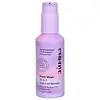What's inside
What's inside
 Key Ingredients
Key Ingredients

No key ingredients
 Benefits
Benefits

 Concerns
Concerns

 Ingredients Side-by-side
Ingredients Side-by-side

Water
Skin ConditioningHydrolyzed Soy Protein
HumectantStearyl Alcohol
EmollientBehentrimonium Methosulfate
Cetearyl Alcohol
EmollientCetyl Alcohol
EmollientArgania Spinosa Kernel Oil
EmollientHydrolyzed Vegetable Protein
Skin ConditioningAdansonia Digitata Seed Oil
EmollientPrunus Amygdalus Dulcis Oil
Skin ConditioningCocos Nucifera Oil
MaskingRicinus Communis Seed Oil
MaskingAloe Barbadensis Leaf Juice
Skin ConditioningPanthenol
Skin ConditioningHydrogenated Castor Oil/Sebacic Acid Copolymer
EmollientPolyquaternium-6
Hydroxypropyl Guar
Emulsion StabilisingGuar Hydroxypropyltrimonium Chloride
Skin ConditioningDimethicone
EmollientBenzoic Acid
MaskingDehydroacetic Acid
PreservativePhenoxyethanol
PreservativeParfum
MaskingWater, Hydrolyzed Soy Protein, Stearyl Alcohol, Behentrimonium Methosulfate, Cetearyl Alcohol, Cetyl Alcohol, Argania Spinosa Kernel Oil, Hydrolyzed Vegetable Protein, Adansonia Digitata Seed Oil, Prunus Amygdalus Dulcis Oil, Cocos Nucifera Oil, Ricinus Communis Seed Oil, Aloe Barbadensis Leaf Juice, Panthenol, Hydrogenated Castor Oil/Sebacic Acid Copolymer, Polyquaternium-6, Hydroxypropyl Guar, Guar Hydroxypropyltrimonium Chloride, Dimethicone, Benzoic Acid, Dehydroacetic Acid, Phenoxyethanol, Parfum
Water
Skin ConditioningPropylene Glycol
HumectantDimethicone
EmollientPhenoxyethanol
PreservativePolyquaternium-11
Guar Hydroxypropyltrimonium Chloride
Skin ConditioningCetyl Alcohol
EmollientParfum
MaskingHydroxypropyl Guar
Emulsion StabilisingCaprylyl Glycol
EmollientCeteth-10 Phosphate
CleansingStyrene/Acrylates Copolymer
Laureth-4
EmulsifyingLaureth-23
CleansingHydrolyzed Soy Protein
HumectantBenzophenone-4
UV AbsorberDisodium EDTA
Sodium Citrate
BufferingHydrolyzed Vegetable Protein
Skin ConditioningCystine Bis-Pg-Propyl Silanetriol
Skin ConditioningArginine
MaskingHexyl Cinnamal
PerfumingSodium Chloride
MaskingLinalool
PerfumingPotassium PCA
HumectantDisodium Laureth Sulfosuccinate
CleansingTocopherol
AntioxidantWater, Propylene Glycol, Dimethicone, Phenoxyethanol, Polyquaternium-11, Guar Hydroxypropyltrimonium Chloride, Cetyl Alcohol, Parfum, Hydroxypropyl Guar, Caprylyl Glycol, Ceteth-10 Phosphate, Styrene/Acrylates Copolymer, Laureth-4, Laureth-23, Hydrolyzed Soy Protein, Benzophenone-4, Disodium EDTA, Sodium Citrate, Hydrolyzed Vegetable Protein, Cystine Bis-Pg-Propyl Silanetriol, Arginine, Hexyl Cinnamal, Sodium Chloride, Linalool, Potassium PCA, Disodium Laureth Sulfosuccinate, Tocopherol
Ingredients Explained
These ingredients are found in both products.
Ingredients higher up in an ingredient list are typically present in a larger amount.
Cetyl Alcohol is a fatty alcohol. Fatty Alcohols are most often used as an emollient or to thicken a product.
Its main roles are:
Though it has "alcohol" in the name, it is not related to denatured alcohol or ethyl alcohol.
The FDA allows products labeled "alcohol-free" to have fatty alcohols.
Learn more about Cetyl AlcoholDimethicone is a type of synthetic silicone created from natural materials such as quartz.
What it does:
Dimethicone comes in different viscosities:
Depending on the viscosity, dimethicone has different properties.
Ingredients lists don't always show which type is used, so we recommend reaching out to the brand if you have questions about the viscosity.
This ingredient is unlikely to cause irritation because it does not get absorbed into skin. However, people with silicone allergies should be careful about using this ingredient.
Note: Dimethicone may contribute to pilling. This is because it is not oil or water soluble, so pilling may occur when layered with products. When mixed with heavy oils in a formula, the outcome is also quite greasy.
Learn more about DimethiconeThis ingredient is derived from guar gum.
It is a conditioning ingredient, meaning it helps soften skin and hair.
Hydrolyzed Soy Protein is a vegan protein made to mimic hydrolyzed collagen. It is created from soy, or glycine soja.
This ingredient is a humectant, meaning it helps hydrate the skin by binding to water. According to a manufacturer, it is also a great hair conditioner.
Read more about hydrolyzed collagen here.
Learn more about Hydrolyzed Soy ProteinWe don't have a description for Hydrolyzed Vegetable Protein yet.
We don't have a description for Hydroxypropyl Guar yet.
Parfum is a catch-all term for an ingredient or more that is used to give a scent to products.
Also called "fragrance", this ingredient can be a blend of hundreds of chemicals or plant oils. This means every product with "fragrance" or "parfum" in the ingredients list is a different mixture.
For instance, Habanolide is a proprietary trade name for a specific aroma chemical. When used as a fragrance ingredient in cosmetics, most aroma chemicals fall under the broad labeling category of “FRAGRANCE” or “PARFUM” according to EU and US regulations.
The term 'parfum' or 'fragrance' is not regulated in many countries. In many cases, it is up to the brand to define this term.
For instance, many brands choose to label themselves as "fragrance-free" because they are not using synthetic fragrances. However, their products may still contain ingredients such as essential oils that are considered a fragrance by INCI standards.
One example is Calendula flower extract. Calendula is an essential oil that still imparts a scent or 'fragrance'.
Depending on the blend, the ingredients in the mixture can cause allergies and sensitivities on the skin. Some ingredients that are known EU allergens include linalool and citronellol.
Parfum can also be used to mask or cover an unpleasant scent.
The bottom line is: not all fragrances/parfum/ingredients are created equally. If you are worried about fragrances, we recommend taking a closer look at an ingredient. And of course, we always recommend speaking with a professional.
Learn more about ParfumPhenoxyethanol is a preservative that has germicide, antimicrobial, and aromatic properties. Studies show that phenoxyethanol can prevent microbial growth. By itself, it has a scent that is similar to that of a rose.
It's often used in formulations along with Caprylyl Glycol to preserve the shelf life of products.
Water. It's the most common cosmetic ingredient of all. You'll usually see it at the top of ingredient lists, meaning that it makes up the largest part of the product.
So why is it so popular? Water most often acts as a solvent - this means that it helps dissolve other ingredients into the formulation.
You'll also recognize water as that liquid we all need to stay alive. If you see this, drink a glass of water. Stay hydrated!
Learn more about Water